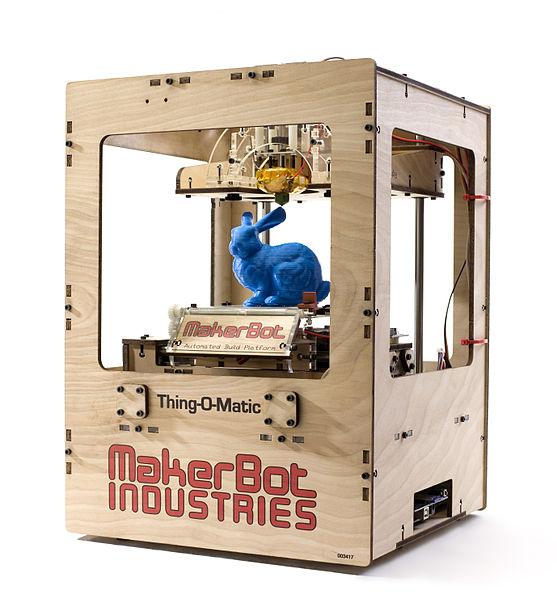Editor-in-Chief
- FMA
- The Fabricator
- FABTECH
- Canadian Metalworking
Our Publications
Categories
- Additive Manufacturing
- Aluminum Welding
- Arc Welding
- Assembly and Joining
- Automation and Robotics
- Bending and Forming
- Consumables
- Cutting and Weld Prep
- Electric Vehicles
- En Español
- Finishing
- Hydroforming
- Laser Cutting
- Laser Welding
- Machining
- Manufacturing Software
- Materials Handling
- Metals/Materials
- Oxyfuel Cutting
- Plasma Cutting
- Power Tools
- Punching and Other Holemaking
- Roll Forming
- Safety
- Sawing
- Shearing
- Shop Management
- Testing and Measuring
- Tube and Pipe Fabrication
- Tube and Pipe Production
- Waterjet Cutting
Industry Directory
Webcasts
Podcasts
FAB 40
Advertise
Subscribe
Account Login
Search
Things—and Thing-O-Matics—change in the 3D printer consumer market
MakerBot’s Thing-O-Matic helped change the perception of 3D printing virtually overnight
- By Don Nelson
- March 28, 2022

MakerBot’s Thing-O-Matic 3D printer was wildly popular when introduced in 2010. Images: Wikimedia Commons
The entire world can be transformed in an instant. Examples: the changes brought about by the COVID-19 pandemic and the war in Ukraine.
Individuals and companies experience rapid transformations too. I thought about this the other day while posting the results of an industry survey published by 3D printer builder MakerBot.
I first learned of MakerBot in 2011 while attending a trade show in New York that the company was exhibiting at. The then-two-year-old startup was promoting Thing-O-Matic, a new desktop 3D printer for the consumer market. The filament-extruding device measured 12 by 12 by 16 in., had a balsa-wood exterior, and was available as a kit for around $1,200.
Though expensive, Thing-O-Matic proved popular. Buyers liked that the printer was open source—allowing them to readily improve and customize it—and some believed Thing-O-Matic and machines like it would fundamentally change the relationship between consumers and manufacturers.
High-amp media exposure boosted Thing-O-Matic’s visibility too. Media outlets that covered it included Wired, PC World, The New York Times, and Fast Company.
The printer also was featured on Stephen Colbert’s former TV show, The Colbert Report. MakerBot co-founder Bre Pettis used a Thing-O-Matic to demonstrate how 3D printing works.
I saw Pettis at a trade show in Detroit in early 2015, two years after industrial 3D printing giant Stratasys bought his company for $403 million. Before learning who he was, I watched him stride up the aisle. People took a half-step sideways to let him pass, like he was a rock star. (With his upswept hair, long sideburns, and thick black glasses, Pettis did resemble English rocker Elvis Costello.)
High-amp media exposure boosted Thing-O-Matic’s visibility. Media outlets that covered it included Wired, PC World, The New York Times, and Fast Company.
Things changed.
Production of the Thing-O-Matic ceased in 2012. MakerBot encountered customer blowback in the 2010s because it decided to move from an open- to a closed-source system. (Click here to read Wired’s account of the events.) It also stopped making consumer products, opting to pursue the industrial and education markets.
As for Pettis, he worked for Stratasys until mid-2015. Afterwards, according to his LinkedIn bio, he founded a number of companies. He currently owns and is CEO of a firm called Bantam Tools that builds desktop milling machines.
About the Author

Don Nelson
2135 Point Blvd.
Elgin, IL 60123
(815)-227-8248
About the Publication
- Podcasting
- Podcast:
- The Fabricator Podcast
- Published:
- 04/16/2024
- Running Time:
- 63:29
In this episode of The Fabricator Podcast, Caleb Chamberlain, co-founder and CEO of OSH Cut, discusses his company’s...
- Trending Articles
- Industry Events
16th Annual Safety Conference
- April 30 - May 1, 2024
- Elgin,
Pipe and Tube Conference
- May 21 - 22, 2024
- Omaha, NE
World-Class Roll Forming Workshop
- June 5 - 6, 2024
- Louisville, KY
Advanced Laser Application Workshop
- June 25 - 27, 2024
- Novi, MI



























